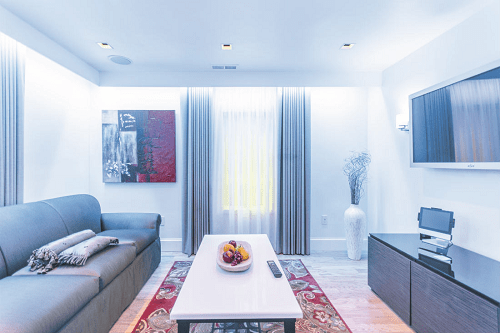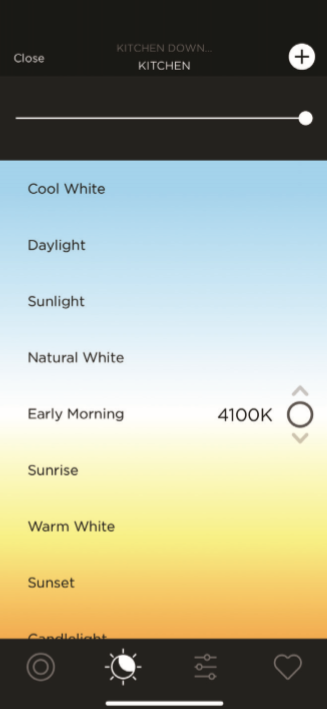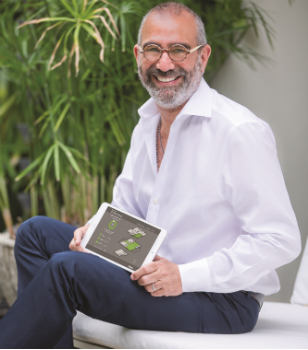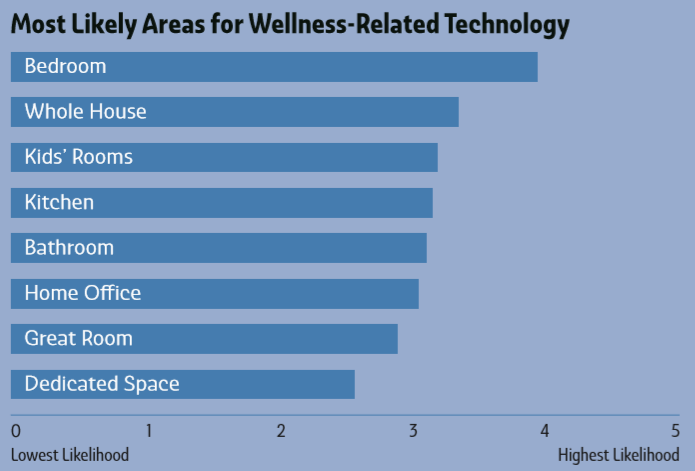
8.1.19 – CE Pro
CE Pro Deep Dive into the nascent biophilia category expands on the channel’s push into circadian lighting, indoor air quality, and other elements with which integrators should become familiar.
Nature. You can never get enough of it. Literally. Genetically, we crave it — a concept embodied by the term biophilia (literally, love of living things) and the principles of biophilic design, or bringing nature into built environments.
The human species is sick because we spend 90% of our time indoors, while our DNA is stuck somewhere in the Stone Age. Our ancestors thrived being in the great outdoors roughly 100% of the time. A few measly millennia can’t undo millions of years of evolution. We still crave nature with every fiber of our being and we suffer physically, mentally and emotionally from our severe nature deprivation.
In the home-technology sector, integrators are warming up to at least one element of biophilic design — human-centric (circadian) lighting — without necessarily grasping the whole “nature thing.”
HCL is a classic tool for mimicking nature (“biomimicry” or “biomimetics”) through changes in lighting intensity and color temperature to roughly replicate natural daylight patterns from dusk until dawn (see here for more common terms to know). Scientific evidence abounds for the health benefits of circadian lighting when you’re trapped indoors for 90% of the day.
It is now big business for office buildings and hospitality, also prisons and schools, and soon homes and apartments where builders, developers and smart-home integrators play.
Why “Well” Will Be “Huge Segment”

demonstrated a new app that
automates circadian lighting —
automation sectors until this year.
Jan Vitrofsky, founder of the high-end integration firm Home Entertainment Design (HED), is like many integrators who are diving into wellness by way of lighting.
“I think we’re at the beginning of what’s going to be a huge segment of what we do for a living,” he tells CE Pro.
His foray into wellness began two years ago with HCL. As a long-time lighting control specialist, he was approached by a high-end homebuilder wanting to know: “What do you know about circadian rhythm lighting?”
The answer back then was: Not a whole lot. But the homeowner wanted the first “WELL” house and had read about this company called Delos, which built the WELL Building Institute and WELL Building Standard. After a trip to New York City to visit the Delos team, Vitrofsky was hooked on the angle.
“I’ve always had a passion for lighting,” he says. “With Delos, I learned about wellness, and more about lighting. I got further entrenched in wellness with them.”
The health benefits of circadian lighting entered the consciousness of home-technology integrators a couple of years ago with the influx of “tunable white” lighting systems and fixtures that could be adjusted for color temperature and intensity to better simulate natural daylight.
Along came Delos-backed Ketra (acquired by Lutron in 2018) to CEDIA Expo 2017, touting perhaps the most automated of circadian simulations, along with the “highest quality color rendering with no color breakup,” the company proclaimed. “Unrivaled range can recreate a solemn, arctic sky and a warm, fire-like glow from the same source.”
The imagery in Ketra’s pitch was deliberate, evoking scenes of the outdoors, which are at the heart of circadian lighting. Humankind (and most living things) evolved to live and thrive outdoors, with full-time exposure to the 24-hour day/ night (diurnal) cycles that comprise a day.
The problem is we spend most of our time indoors, shielded from the natural cues that inform our biological clocks. Lighting is considered to be the most important of these cues.
Rods and cones in the eye sense changes in color temperature (related to wavelength, or spectral output) and lighting intensity. Two rather recent discoveries indicate we have non-visual photosensors in the eyes and skin, which also recognize the ever-changing characteristics of light. All of these receptors send messages to the brain to release serotonin (the “happy chemical”) during the day and melatonin (sleep-inducing hormone) at night.
Disruption of these natural light patterns confuses our highly evolved circadian circuitry, which informs our sleep, hormone secretions, alertness, neurological functions, metabolism, immune systems, moods … pretty much everything that makes us human at the cellular level.
Research over the past decade demonstrates fairly convincingly that natural daylight, or artificial lighting that simulates daylight, makes us more productive and happier during the day and helps us sleep at night; dusk-appropriate lighting in the evening helps us wind down for bedtime.
Let There Be Light … And Indoor Air Quality
In a survey conducted by CE Pro in June 2019, preliminary results indicate 57% of home-technology integrators are well versed or very well versed in the concept of humancentric lighting. Only 10% of respondents say they have never heard of it, with another 12.7% saying it rings a bell.
More than one-quarter (25.3%) of respondents say they are highly interested in, or already implementing, HCL. It’s no wonder. HCL purveyors have been hitting the home-tech channel pretty aggressively for the past few years. Three of the major industry buying groups — HTSA (and partner HTSN), ProSource and Azione — have all added light-fixture vendors to their rosters and launched intensive training programs around the category.

going to be a huge segment of what we
do for a living.” Jan Vitrofsky, Home
Entertainment Design, who was
instrumental in driving Delos wellness
initiatives into the home-tech channel.
Even so, as Vitrofsky notes, “In the wellness sector, lighting is only one of the pillars.”
If lighting is considered the most important pillar in the wellness movement, then indoor air quality (IAQ) probably comes a close second.
Tighter building envelopes and faker products — artificial flooring, cleaners, pesticides and the like — have wreaked havoc on our homes and our health leading to increased incidence of asthma, allergy, pneumonia and other ailments, especially in children and the elderly.
A 2016 study by The Farnsworth Group found 24% of households expressed concerns about “healthy homes.” Of this group, about 70% cited issues related to IAQ — by far the leading source of healthy-housing concern, followed by water quality (36%), and harmful materials (30%).
When asked to pick their top three concerns about indoor air and “environmental” quality, managing household dust and dander won the day with 47% of the vote, followed by dampness/moisture (36%) and water quality (25%). Outdoor pollution surrounding the home came in fourth place with a paltry 22%.
According to the EPA, indoor air pollutants often are two to five times higher indoors than out.
Unlike with HCL, the health benefits of clean indoor air have been well known for decades, but smart-home pros are only just waking up to it.
When asked about their familiarity/ engagement with IAQ as it relates to wellness, only 20.3% of respondents expressed a high level of interest in IAQ sensors and systems (compared to 25.3% for HCL).
Interestingly — again considering how long we’ve known about IAQ’s contribution (and detriment) to health and well-being — a whopping 38% of respondents said they were not familiar or barely familiar with IAQ as it relates to wellness. That’s more than the number of respondents (35%) with the same low level of familiarity with HCL, a relatively new phenomenon.
Even so, home-tech pros see opportunity in IAQ. When asked about the business prospects of IAQ today versus previous years, more than 40% of respondents said they are more bullish or much more bullish on the category these days than previous years.
The leap to IAQ would be an easy one for smart-home pros, considering many already install and integrate HVAC controls, which incorporate IAQ-related elements such as ventilation and humidification.
Read Next: Biophilia—Nature Sounds vs. White Noise for Productivity and Wellness
Ask them about the prospects for energy efficiency today versus previous years and nearly 47% will tell you they’re more bullish or much more bullish today (vs. 40% for IAQ). Another 25% say they’ve been highly bullish in the past, and they still are today (vs. 20% for IAQ).
Beyond whole-house air purifiers and ventilation systems, home technologists have other IAQ tools at their disposal, including motorized skylights. Velux, a leader in motorized skylights, is now pitching Velux Active, working with IAQ sensors from Netatmo to automate the operation of skylights for optimal ventilation.
“Smart sensors continuously monitor the temperature, humidity and CO2 levels in your home,” the company says, “and open or close your skylights and blinds to create a healthier indoor climate.”
For its part, Delos is trying to accelerate interest in IAQ among smart-home pros. The company joined the industry buying group HTSA recently and has been training dealer members on its full wellness ecosystem, including HCL, IAQ, water quality and more. So far, three groups of dealers have gone through the training.
Vitrofsky is just one HTSA member that started with HCL in the wellness category, and now embraces IAQ, thanks to Delos. He was, in fact, the guy who brought Delos to HTSA and the home tech channel in the first place.
A Much Bigger Wellness Play
So … we have HCL that simulates natural daylight and IAQ systems that mimic our once-clean outdoor air. What do they have in common? Nature. The outdoors.
Besides natural lighting and clean air, what are the other natural things we’re missing in our lives?
As it turns out: a lot, as a rich trove of research tells us. Every little nuance of the natural world is important to our wellbeing. Not just the quality of air, but the stochastic movement of the air. Not just the lighting produced by the sun, but the sensation of it. And importantly: the sounds, scents, visuals and environmental variability that recall our vast history of outdoor survival.
Think about 24-hour daylight cycles — the rising of the sun, its intensity during the day, and the fading to dark at bedtime. Outdoor temperatures closely follow warming and cooling patterns with natural human responses to those temperatures. Today, we live in a world that is inconsistent with our biological function.
As electrification disrupted natural lighting conditions, so too did AC and heating smooth out the normal ups and downs of ambient temperature. We did not evolve to freeze during the day in a too-cold office or conference room. Cold conditions tell us it’s time to wind down. We get sleepy when it’s chilly. (Why, then, is every conference room in America freezing cold, with dim, warm lighting?!)
“Circadian climate” is much easier to implement than circadian lighting: Cool at night and warmer during the day. Done.
Not so fast. There are more than two temperatures — warm and cold — in the great outdoors. Nature gives us a continuum (as with lighting), and the variations themselves play a key role in normalizing our biological clocks.
As the temperature changes, it tells our brains to start mindwork or wrap it up for the day. But things don’t automatically go from cold to warm and vice versa… the temperature gradually changes. And yet the temperature in virtually every commercial space remains constant throughout the day — around 70 degrees depending on the time of year (due to clothing selections) because that’s where 80% of occupants tend to be the most comfortable, according to ASHRAE, which specifies such things.
Even with “optimal” or “most-comfortable” lighting and temperature settings, however, the stagnant conditions stupefy our human sensibilities. Without these fluctuations, research shows, we get fatigued, complacent, error-prone and unproductive. We lose our sense of time. We frustrate our circadian cycles.

Experts recommend creating not just optimal temperature and lighting settings but also variable temperature and lighting — seating options with different lighting levels or heat gain, personal fans and heaters, even variable conductance materials like a cold slab of marble to lean against or a warm cushion.
Research indicates that “pleasant thermal sensations are better perceived” when humans are already in extreme conditions, such as a cold splash of water when it’s hot; a hot cup of coffee when it’s cold.
So there is some science behind the new Wave bracelet from Embr Labs, which “cools or warms the temperature-sensitive skin on your wrist in waves, creating a natural response that makes you feel 5 degrees more comfortable overall,” the company claims.
When it comes to thermal- and airflow variability, products like Dyson air-movement products, including the Pure Hot + Cool Link, are available, but can’t be integrated into a bigger biophilic ecosystem.
Whirlwind FX makes an interesting air movement product called Vortx, described by the manufacturer as “the world’s first environmental simulator for PC gaming.”
Vortx, which currently has a closed API, creates wind and heat effects that synchronize with the action on the screen.
Click here to see more charts and graphs of our findings!
![]()

Julie Jacobson is founding editor of CE Pro, the leading media brand for the home-technology channel. She has covered the smart-home industry since 1994, long before there was much of an Internet, let alone an Internet of things. Currently she studies, speaks, writes and rabble-rouses in the areas of home automation, security, networked A/V, wellness-related technology, biophilic design, and the business of home technology. Julie majored in Economics at the University of Michigan, spent a year abroad at Cambridge University, and earned an MBA from the University of Texas at Austin. She is a recipient of the annual CTA TechHome Leadership Award, and a CEDIA Fellows honoree. A washed-up Ultimate Frisbee player, Julie currently resides in San Antonio, Texas and sometimes St. Paul, Minn. Follow on Twitter: @juliejacobson Email Julie at julie.jacobson@emeraldexpo.com
